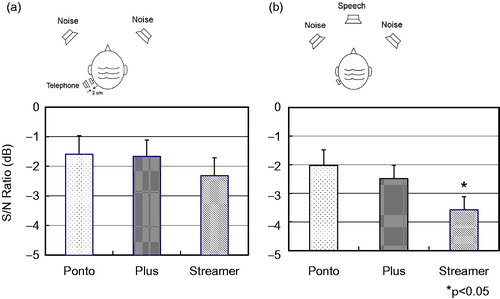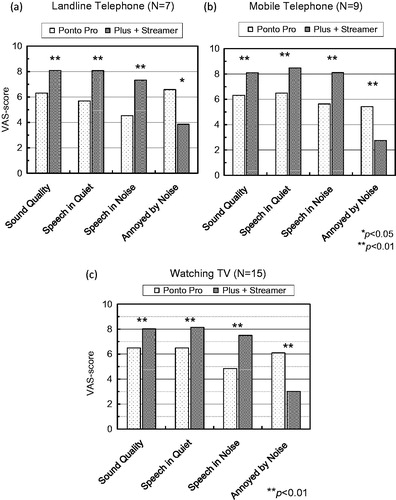Figures & data
Figure 1. Left and right pure-tone thresholds of the 19 subjects for bone conduction (filled symbols) and air conduction (open symbols), expressed in 25-, 50-, and 75-percentiles and shown with downward pointing triangles, circles and upward pointing triangles, respectively.

Figure 2. Setup for calibrating the acoustic and streamer telephone condition. (1, 2): PC and RME MultiFace II D/A convertor. (3): Ecler MPA4-80R power amplifier. (4, 5): TBS-25 hearing aid test box (Interacoustics) with built-in loudspeaker and Siemens Dect Gigaset E49H telephone. (6): ConnectLine Phone transmitter connected to the landline of the Dect telephone and linked to a streamer. (7, 8): Human Technik Flashtel Comfort landline telephone receiver and Ponto Pro or Ponto Plus sound processor with TU-1000 skull simulator in a TBS-25. (9, 10): PC and RME FireFace UCX A/D convertor.

Figure 3. Results for (a) the landline telephone with the digits-in-noise test (Smits, 2004) and (b) for the TV-condition with the sentence-in-noise test (Plomp & Mimpen, Citation1979) for Ponto Pro, Ponto Plus, and Ponto Plus with streamer. The differences in the telephone condition (a) are statistically not significant (p >0.05). In the TV-condition (b), the SRT with streamer is 1.6 dB and 1.1 dB (p <0.05) lower (more favourable) than for Ponto Pro and Ponto Plus, respectively.

Figure 4. Visual-analogue scores for Ponto Pro and Ponto Plus with streamer for: (a) landline telephone (seven subjects); (b) mobile phone ( nine subjects); and (c) watching TV (15 subjects). Scores for sound quality, speech in quiet, and speech in noise were significantly higher (p <0.01) for Ponto Plus with streamer than for Ponto Pro. The annoyance by ambient noise was strongly reduced (p <0.01) for the Ponto Plus and streamer combination for mobile phone and watching TV. Due to the smaller number of respondents the difference in noise annoyance for landline telephone was only statistically significant at the 5% level.

